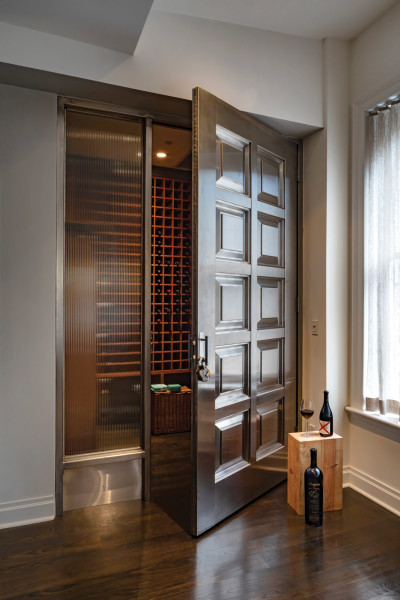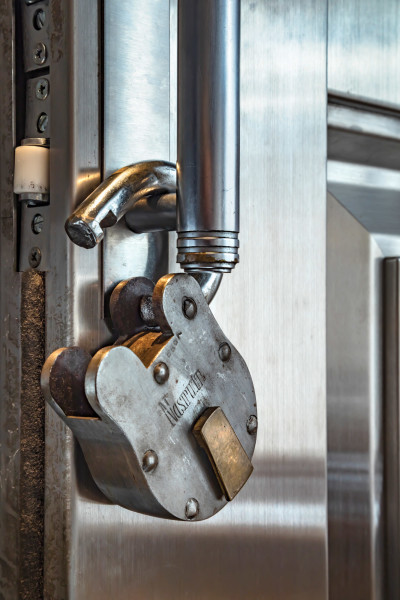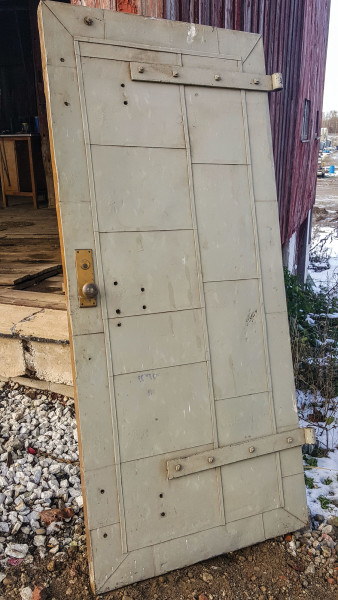The attractive, paneled door is made of steel. Mark Rauth
Steel doors used for security and fire safety date back to the 19th century. This one, bought as salvage, is in a spacious, 19th-century New York City apartment, formerly a warehouse. Tall ceilings and open space make it a challenge to find architectural fittings of large-enough scale. So when the owner came across the huge door, he knew it would be perfect to enclose a small wine room by the apartment’s entry hall.
The Process
1. FRAMING THE DOOR OPENING
The steel door, built for Tiffany’s Chicago store, is a substantial 9’10” tall, 2″ thick, and weighs 300 pounds. Too big for the building’s elevator, it had to be carried up stairs to the fifth-floor apartment.
The door came as unit with a ribbed-glass sidelight along with the steel jamb, making installation straightforward.
The first task was construction of a steel frame that was tied into the walls and a pre-existing steel I-beam in the ceiling for support, to ensure that the frame would support a hefty door.
The frame was constructed from steel channels on-site, plumbed, leveled, and squared, then welded into place. It was made slightly wider and higher ( ” on each side and the top) than the actual doorjamb to allow room for shimming and final adjustments.
The old padlock is just for show. Mark Rauth
2. SETTING THE JAMB
The steel jamb and sidelight were set into the frame with flat-face chamfered bolts through existing bolt holes in the jamb, by drilling and tapping them into the steel frame. The jamb was not tied into the ceiling, as it was strong enough to carry the door’s weight and still allow adjustments.
The steel header and side jambs were leveled and plumbed to prevent twisting and misalignment; a 1 ” screw was drilled into one of the tabs at the top of the frame to make sure the jamb stayed secure. Then the level was again placed against one side of the frame, and the bottom adjusted until it was level. A screw was drilled into a bottom tab, and the process repeated on the other side. Once all sides were plumb and level, screws were drilled into all the tabs. A professional-grade level was used to ensure accuracy.
Recently on eBay: a steel fire safety door salvaged from a 1920s school building. John Neitzel
3. HANGING THE DOOR
The door then was set carefully into the jamb, and threaded hinge screws used to attach the hinges to the doorjambs. Care was taken not to scratch or damage the metal during installation. Final adjustments were made with thin metal shims behind the hinges to make sure they were properly aligned.
Fortunately, the original mortise lockset was intact, and it was reset to align with the doorjamb. Pre-existing holes in the door were used to avoid further drilling. The door’s vintage padlock was included; it was hung, unlocked, from the handle as an amusing accent.
Maintaining Stainless Steel
Stainless steel resists rust and corrosion but is not necessarily “stainless,” as fingerprints and water leave marks. Do this:
• Clean with the “finish grain” of the steel, not against it, to avoid residue.
• Use soft cloths (100% cotton for no lint).
• Wash off fingerprints and grime with dishsoap and a damp rag. Dry with a clean cloth. Then polish with a drop of baby oil or mineral oil to get a sheen.
• Glass cleaners also will remove fingerprints and marks.
• The author recommends Weiman Stainless Steel Cleaner and Polish.







